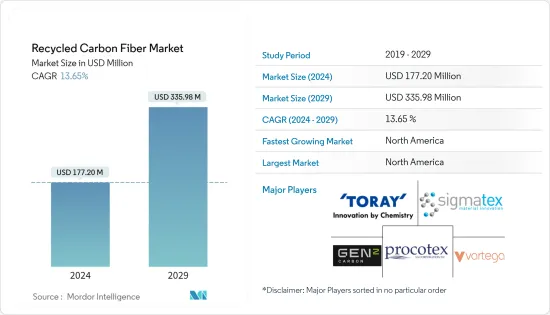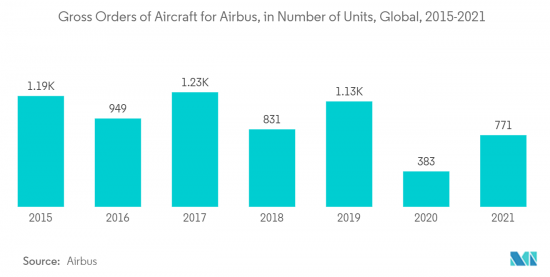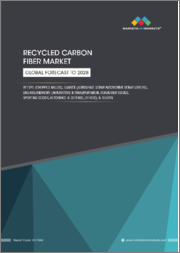
|
시장보고서
상품코드
1407949
재생 탄소섬유(RCF) - 시장 점유율 분석, 산업 동향 및 통계, 성장 예측(2024-2029년)Recycled Carbon Fiber - Market Share Analysis, Industry Trends & Statistics, Growth Forecasts 2024 - 2029 |
||||||
■ 보고서에 따라 최신 정보로 업데이트하여 보내드립니다. 배송일정은 문의해 주시기 바랍니다.
재생 탄소섬유(RCF)(Recycled Carbon Fiber) 시장 규모는 2024년에 1억 7,720만 달러로 추정되며, 2029년에는 3억 3,598만 달러에 이를 것으로 예측되며, 예측 기간(2024-2029년)의 CAGR은 13.65%로 추이하며 성장 할 것으로 예상됩니다.

주요 하이라이트
- 2020년 COVID-19는 공급망 혼란으로 인해 시장에 부정적인 영향을 미쳤습니다. 팬데믹의 확대에 따라 탄소섬유 재생과 관련된 많은 제조 공장이 세계적으로 엄격한 운영 중단을 강요했습니다. 그러나 풍력에너지를 비롯한 다양한 최종사용자 산업에서 수요 증가로 규제가 해제된 이래 이 분야는 회복되고 있습니다.
- 단기적으로는 경량 자동차 수요 증가, 탄소섬유 스크랩 재생 증가, 풍력에너지 분야에서 재사용 증가, 재생 탄소섬유(RCF) 비용 효과 등이 시장 수요를 견인하는 요인 중 하나입니다.
- 재생 탄소섬유(RCF)의 다양한 대안의 가용성과 공급망의 안전성은 시장 성장을 방해하는 요인입니다.
- 지속가능성 중시로의 전환, 재생기술의 연구개발의 진전, 적층조형 및 3D 프린팅 분야로부터 잠재적인 수요 증가는 향후 수년간 시장에 기회를 가져올 가능성이 높습니다.
- 북미는 시장을 독점하고 예측 기간 동안 가장 높은 CAGR을 나타낼 것으로 예상됩니다.
재생 탄소섬유(RCF) 시장 동향
항공우주 및 방위 산업에서 용도 증가
- 재생 탄소섬유(RCF)는 항공우주 및 방위 산업에서 사용되는 복합재료의 제조에 사용되는 새로운 탄소섬유와 유사한 특성을 가지고 있습니다. 이러한 탄소섬유는 가혹한 조건 하에서 고온에서 내구성, 내마모성, 내식성 등 항공우주 및 방위 산업에서 사용되는 부품에 특유한 이점을 제공합니다.
- 재생 탄소섬유(RCF)는 연비를 개선하기 위해 알루미늄 대신 항공기에 사용됩니다. 가벼운 재료와 구조로 군용기에서는 더 많은 연료와 페이로드를, 민간기에서는 더 많은 연료와 페이로드를 운반할 수 있습니다.
- 경량 재료는 온실가스 배출량과 매립지로 보내지는 폐기물의 양을 줄이기 위해 사용됩니다. 예를 들어, 보잉 787형 기계는 20% 경량화되어 연비를 10%에서 12% 가까이 향출시킬 수 있었습니다.
- 또한 항공우주 업계에서는 항공기 폐기물의 심각한 문제를 해결하기 위해 재활용 탄소 섬유에 대한 선호도가 높아지고 있습니다. 전 세계 항공우주 산업에서는 2030년까지 약 6000-8000대의 항공기가 수명을 다할 것으로 예상되며, 이는 항공우주 산업에서 탄소 재활용의 잠재적 원천이 될 수 있습니다.
- Airbus는 2020-2025년까지 탄소섬유 폐기물의 95%를 재생하고 5%를 항공우주 분야에 재이용한다는 목표를 내걸고 있습니다. Airbus의 항공기 총 수주수는 2020년 383기에 비해 2021년 771기가 됐습니다.
- 여객수 증가와 항공기 퇴역 증가로 향후 20년간 4만 4,040대(평가액 6조 8,000억 달러)의 새로운 제트기가 필요할 것으로 예상됩니다. 세계의 민간 항공기는 모든 신조기와 현역으로 계속될 수 있는 제트기를 고려하면 2038년까지 5만 660기에 달할 것으로 예상됩니다.
- 국제항공운송협회(IATA)에 따르면 민간항공사의 세계 매출은 2020년에는 3,730억 달러로 평가되었고, 2021년에는 4,720억 달러로 추정되며 전년대비 26.7%의 성장률을 기록 했습니다. 또한 2022년 말에는 6,580억 달러에 달할 것으로 예상됩니다.
- Boeing에 따르면 2040년까지 세계 민간 항공기 보유 대수는 4만 9,000대를 넘어 중국, 유럽, 북미, 아시아 태평양 국가들이 각각 신형기 납품의 약 20%를 차지하고 나머지 20%는 기타 신흥 시장으로 이동한다고합니다.
- 이러한 요인들로부터 재생 탄소섬유(RCF) 시장은 예측 기간 동안 세계적으로 성장할 것으로 보입니다.

시장을 독점하는 북미
- 북미가 시장을 독점할 것으로 예상됩니다. 이 지역에서 미국은 GDP에서 가장 큰 경제 강국입니다. 미국과 캐나다는 세계에서 가장 빠르게 성장하는 신흥국 중 하나입니다.
- 급성장하는 자동차산업과 항공우주산업이 북미에서 연구되고 있는 시장 성장을 견인하고 있습니다. 전략적 개척, 유명한 자동차 제조업체, 주요 재생 탄소섬유(RCF) 제조업체의 존재 및 재생 탄소섬유(RCF) 제품과 관련된 모든 기술 발전은 이 지역 시장 성장에 기여합니다.
- 미국은 이 지역의 재생 탄소섬유(RCF) 소비의 지도자이며 대기업이 사용합니다. 자동차 경량화로 인해 경량 재료에 대한 수요가 높아지면서 이 지역에서는 자동차 및 항공우주의 최종 이용 산업에서 재생 탄소섬유(RCF)의 사용이 증가하고 있습니다.
- 또한 미국에서는 연방항공국(FAA)에 따르면 이 나라의 상업용 항공기 수는 2020년에 5,882기가 되었고 전년 대비 22.9%의 감소율을 기록했습니다. 그러나 2041년에는 8,756기까지 증가했으며, CAGR은 2%가 될 것으로 예측되고 있습니다. 이로 인해 항공우주산업의 여러 용도에서 탄소섬유 수요가 증가할 것으로 예상됩니다.
- 캐나다에서는 퀘벡주 복합재료 개발센터(Centre developpement des composites du Quebec)(CDCQ)가 탄소섬유를 포함한 다양한 복합재료의 가치사슬에 관한 다양한 활동을 하고 있습니다. 이 센터는 또한 탄소섬유의 재생에도 적극적으로 노력하고 있습니다.
- 세계적으로 보면 캐나다는 민간 비행 시뮬레이션에서 1위, 민간 엔진 생산에서 3위, 민간 항공기 생산에서 4위를 차지하고 있습니다. 모든 주요 카테고리에서 상위 5위를 차지하는 것은 캐나다뿐입니다. 캐나다 항공우주 산업은 제품의 70% 이상을 6대륙 190개국 이상으로 수출하고 있습니다.
- 캐나다의 풍력에너지는 발전량의 3.5%를 차지하며, 이 지역에서 두 번째로 중요한 재생 가능 에너지 발전소가 되었습니다. 풍력에너지는 세계의 탄소 배출량 넷 제로를 달성하는데 중요한 역할을 하고 있습니다. 캐나다는 수력, 바이오매스, 풍력, 태양광 등 다양한 에너지원을 가진 지역이기 때문에 신재생에너지의 생산과 이용에 있어서 세계를 선도하는 국가 중 하나입니다.
- 이러한 요인으로부터 이 지역의 재생 탄소섬유(RCF) 시장은 예측 기간 동안 안정된 성장이 예상됩니다.
재생 탄소섬유(RCF) 산업 개요
재생 탄소섬유(RCF) 시장은 부분적으로 통합되어 있습니다. 이 시장의 주요 기업으로는 Toray Industries Inc., Procotex, Vartega Inc., Gen 2 Carbon Limited, Sigmatex 등이 있습니다.
기타 혜택 :
- 엑셀 형식 시장 예측(ME) 시트
- 3개월간 애널리스트 서포트
목차
제1장 서론
- 조사의 전제 조건
- 조사 범위
제2장 조사 방법
제3장 주요 요약
제4장 시장 역학
- 성장 촉진 요인
- 경량 자동차에 대한 수요 증가
- 탄소섬유 스크랩의 재생과 풍력에너지 분야에서 재이용의 확대
- 재생 탄소섬유(RCF)의 비용 효과
- 억제 요인
- 다양한 대체품의 이용가능성
- 재생 탄소섬유(RCF) 공급망의 안전성
- 산업 가치사슬 분석
- Porter's Five Forces 분석
- 공급기업의 협상력
- 구매자의 협상력
- 신규 참가업체의 위협
- 대체품의 위협
- 경쟁도
제5장 시장 세분화(시장 규모 : 매출액)
- 유형
- 세절 재생 탄소섬유(RCF)
- 분쇄 재생 탄소섬유(RCF)
- 공급원
- 자동차용 스크랩
- 항공우주 스크랩
- 기타
- 최종 사용자 산업
- 자동차
- 항공우주 및 방위
- 풍력에너지
- 스포츠 용품
- 기타 최종 사용자 산업
- 지역
- 아시아 태평양
- 중국
- 인도
- 일본
- 한국
- 기타 아시아 태평양
- 북미
- 미국
- 캐나다
- 멕시코
- 유럽
- 독일
- 영국
- 이탈리아
- 프랑스
- 기타 유럽
- 기타
- 남미
- 중동 및 아프리카
- 아시아 태평양
제6장 경쟁 구도
- M&A, 합작사업, 제휴, 협정
- 시장 랭킹 분석
- 주요 기업의 전략
- 기업 개요
- Alpha Recyclage Composites
- Carbon Conversions
- Carbon Fiber Recycling
- Carbon Fiber Remanufacturing
- Gen 2 Carbon Limited
- Karborek RCF
- Mitsubishi Chemical Holdings Corporation.
- Procotex
- Shocker Composites LLC
- Sigmatex
- Toray Industries Inc.
- Vartega Inc.
제7장 시장 기회 및 향후 동향
- 지속가능성으로의 이동
- 재생 기술의 연구 개발의 진전
- 적층 조형과 3D 프린팅 분야로부터 잠재 수요 증가

The Recycled Carbon Fiber Market size is estimated at USD 177.20 million in 2024, and is expected to reach USD 335.98 million by 2029, growing at a CAGR of 13.65% during the forecast period (2024-2029).
Key Highlights
- The market was negatively impacted by COVID-19 in 2020 due to disruption in the supply chain. As the pandemic spread, many manufacturing plants involved in the recycling of carbon fiber globally were shut down due to the strict lockdowns. However, the sector has been recovering since restrictions were lifted owing to increased demand from various end-user industries, such as wind energy.
- Over the short term, the rising demand for lightweight vehicles, growing carbon fiber scrap recycling, its increasing reuse in the wind energy sector, and the cost-effectiveness of recycled carbon fiber are some of the factors driving the market demand.
- The availability of various substitutes and supply chain security for recycled carbon fiber are the factors hindering the market's growth.
- Shifting focus toward sustainability, advancement in research and development for recycling techniques, and increasing potential demand from additive manufacturing and 3D printing sectors are likely to create opportunities for the market in the coming years.
- The North American region is expected to dominate the market and is likely to witness the highest CAGR during the forecast period.
Recycled Carbon Fiber Market Trends
Increasing Usage in the Aerospace and Defense Industry
- Recycled carbon fiber possesses similar properties to new carbon fiber used for manufacturing composites that are used in the aerospace and defense industry. These carbon fibers offer specific advantages to components used for the aerospace and defense industry, such as durability in harsh conditions and at high temperatures, abrasion resistance, and corrosion resistance.
- Recycled carbon fiber has replaced aluminum in aircraft to improve fuel economy. Lightweight materials and structures allow military aircraft to carry more fuel and payload while in commercial aircraft.
- Lightweight materials are used to reduce greenhouse gas emissions and the amount of waste sent to landfills. For instance, the Boeing 787 was made 20% lighter, which helped in increasing the fuel economy by nearly 10% to 12%.
- Moreover, the preference for recycled carbon fiber is also increasing in the aerospace industry to manage the significant problem of aircraft waste. It is estimated that, in the global aerospace industry, about 6000-8000 aircraft will reach the end of their service life by 2030, which may create a potential source for carbon recycling in the industry.
- Airbus has set a target of recycling 95% of its carbon fiber waste by 2020-2025, with 5% recycled back into the aerospace sector. The gross orders of aircraft for airbus were 771 units in 2021, as compared to 383 units in 2020.
- The growing passenger volumes and increasing retirements of aircraft are expected to drive the need for 44,040 new jets (valued at USD 6.8 trillion) over the next two decades. The global commercial fleet is expected to reach 50,660 aircraft by 2038, considering all the new aircraft and jets that may remain in service.
- According to the International Air Transport Association (IATA), the global revenue for commercial airlines was valued at USD 373 billion in 2020 and was estimated at USD 472 billion in 2021, registering a growth rate of 26.7% Y-o-Y. Furthermore, the revenue was expected to reach USD 658 billion by the end of 2022.
- According to Boeing, by 2040, the worldwide commercial fleet will exceed 49,000 planes, with China, Europe, North America, and the Asia-Pacific countries each accounting for around 20% of new plane deliveries and the remaining 20% going to other rising markets.
- Owing to all these factors, the market for recycled carbon fiber is likely to grow globally during the forecast period.

The North American Region to Dominate the Market
- The North American region is expected to dominate the market. In the region, the United States is the largest economy in terms of GDP. The United States and Canada are among the fastest emerging economies in the world.
- The fast-growing automotive and aerospace industries are driving the growth of the market studied in the North American region. Strategic developments, the presence of established car manufacturers, leading recycled carbon fiber manufacturers, and technological advancements related to recycled carbon fiber products all contribute to the market's growth in this region.
- The United States is the region's leader in the consumption of recycled carbon fiber, which is used by major corporations. Due to the growing demand for lightweight materials to reduce vehicle weight, the use of recycled carbon fiber in the automotive and aerospace end-use industries has increased in the region.
- Moreover, in the United States, according to the Federal Aviation Administration (FAA), the number of aircraft in the country's commercial fleet accounted for 5,882 in 2020, witnessing a decline rate of 22.9% compared to the previous year. However, the commercial fleet is projected to increase to 8,756 in 2041, with an average annual growth rate of 2% per year. This is expected to increase the demand for carbon fiber from multiple applications in the aerospace industry.
- In Canada, the country has a Centre de developpement des composites du Quebec (Composite Development Centre of Quebec) (CDCQ) engaged in various activities related to the value chain of various composite materials, including carbon fibers. The center is also actively involved in the recycling of carbon fiber as one of its major activities.
- Globally, Canada ranks first in civil flight simulation, third in civil engine production, and fourth in civil aircraft production. It is the only nationally ranked in the top five of all the key categories. The Canadian aerospace industry exports over 70% of its products to over 190 countries across six continents.
- Wind energy in Canada accounts for 3.5% of electricity generation, being the region's second most important renewable energy source. Wind energy plays a crucial role in reaching global net-zero carbon emissions. Canada is one of the world leaders in producing and using renewable power due to its diversified geography with hydro, biomass, wind, and solar energy sources.
- Due to all such factors, the market for recycled carbon fiber in the region is expected to have steady growth during the forecast period.
Recycled Carbon Fiber Industry Overview
The recycled carbon fiber market is partially consolidated in nature. Some of the major players in the market include Toray Industries Inc., Procotex, Vartega Inc., Gen 2 Carbon Limited, and Sigmatex, among others (not in any particular order).
Additional Benefits:
- The market estimate (ME) sheet in Excel format
- 3 months of analyst support
TABLE OF CONTENTS
1 INTRODUCTION
- 1.1 Study Assumptions
- 1.2 Scope of the Study
2 RESEARCH METHODOLOGY
3 EXECUTIVE SUMMARY
4 MARKET DYNAMICS
- 4.1 Drivers
- 4.1.1 Rising Demand For Lightweight Vehicles
- 4.1.2 Growing Carbon Fiber Scrap Recycling and its Reuse in the Wind Energy Sector
- 4.1.3 Cost Effectiveness of Recycled Carbon Fiber
- 4.2 Restraints
- 4.2.1 Availability of Various Substitutes
- 4.2.2 Supply Chain Security for Recycled Carbon Fiber
- 4.3 Industry Value Chain Analysis
- 4.4 Porter's Five Forces Analysis
- 4.4.1 Bargaining Power of Suppliers
- 4.4.2 Bargaining Power of Buyers
- 4.4.3 Threat of New Entrants
- 4.4.4 Threat of Substitute Products and Services
- 4.4.5 Degree of Competition
5 MARKET SEGMENTATION (Market Size in Revenue)
- 5.1 Type
- 5.1.1 Chopped Recycled Carbon Fiber
- 5.1.2 Milled Recycled Carbon Fiber
- 5.2 Source
- 5.2.1 Automotive Scrap
- 5.2.2 Aerospace Scrap
- 5.2.3 Other Sources
- 5.3 End-user Industry
- 5.3.1 Automotive
- 5.3.2 Aerospace and Defense
- 5.3.3 Wind Energy
- 5.3.4 Sporting Goods
- 5.3.5 Other End-user Industries
- 5.4 Geography
- 5.4.1 Asia-Pacific
- 5.4.1.1 China
- 5.4.1.2 India
- 5.4.1.3 Japan
- 5.4.1.4 South Korea
- 5.4.1.5 Rest of Asia-Pacific
- 5.4.2 North America
- 5.4.2.1 United States
- 5.4.2.2 Canada
- 5.4.2.3 Mexico
- 5.4.3 Europe
- 5.4.3.1 Germany
- 5.4.3.2 United Kingdom
- 5.4.3.3 Italy
- 5.4.3.4 France
- 5.4.3.5 Rest of Europe
- 5.4.4 Rest of the World
- 5.4.4.1 South America
- 5.4.4.2 Middle East and Africa
- 5.4.1 Asia-Pacific
6 COMPETITIVE LANDSCAPE
- 6.1 Mergers and Acquisitions, Joint Ventures, Collaborations, and Agreements
- 6.2 Market Ranking Analysis
- 6.3 Strategies Adopted by Leading Players
- 6.4 Company Profiles
- 6.4.1 Alpha Recyclage Composites
- 6.4.2 Carbon Conversions
- 6.4.3 Carbon Fiber Recycling
- 6.4.4 Carbon Fiber Remanufacturing
- 6.4.5 Gen 2 Carbon Limited
- 6.4.6 Karborek RCF
- 6.4.7 Mitsubishi Chemical Holdings Corporation.
- 6.4.8 Procotex
- 6.4.9 Shocker Composites LLC
- 6.4.10 Sigmatex
- 6.4.11 Toray Industries Inc.
- 6.4.12 Vartega Inc.
7 MARKET OPPORTUNITIES AND FUTURE TRENDS
- 7.1 Shifting Focus Toward Sustainability
- 7.2 Advancement in Research and Development for Recycling Techniques
- 7.3 Increasing Potential Demand from Additive Manufacturing and 3D Printing Sectors
비교리스트


















